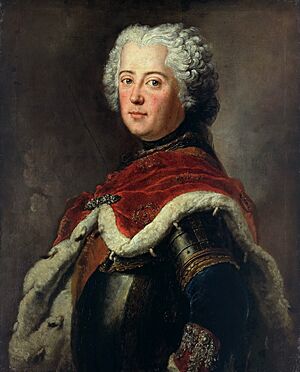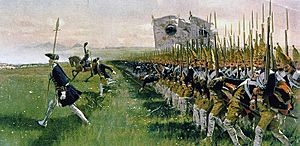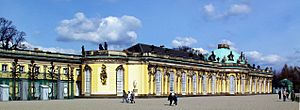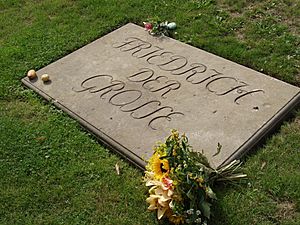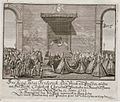Frederick II of Prussia facts for kids
Quick facts for kids Frederick II |
|
|---|---|

Frederick II, aged 68, by Anton Graff
|
|
| King of Prussia; Elector of Brandenburg | |
| Reign | 31 May 1740 – 17 August 1786 (46 years, 78 days) |
| Predecessor | Frederick William I |
| Successor | Frederick William II |
| Chief Minister |
List
Heinrich von Podewils
Georg Dietlof von Arnim-Boitzenburg Count Karl-Wilhelm Finck von Finckenstein Friedrich Anton von Heinitz |
| Born | 24 January 1712 Berlin, Kingdom of Prussia |
| Died | 17 August 1786 (aged 74) Potsdam, Prussia |
| Burial | Sanssouci, Potsdam |
| Spouse | Elisabeth Christine of Brunswick-Wolfenbüttel |
| House | House of Hohenzollern |
| Father | Frederick William I of Prussia |
| Mother | Sophia Dorothea of Hanover |
Frederick II (German: Friedrich II; 24 January 1712 – 17 August 1786) was a powerful ruler known as the King in Prussia from 1740 to 1786. He belonged to the Hohenzollern family. As a prince-elector of the Holy Roman Empire, he was also known as Frederick IV Margrave of Brandenburg. He was also the ruler of the Principality of Neuchâtel. People often called him Frederick the Great (German: Friedrich der Große) and gave him the nickname der alte Fritz ("Old Fritz").
When he was young, Frederick was very interested in music and philosophy. He didn't like military training as much. Frederick had a strict father, Frederick William I. He once tried to escape with his childhood friend, Hans Hermann von Katte. They were caught, and this was a very difficult time for Frederick.
Soon after becoming King, Frederick attacked Austria and took control of Silesia during the Silesian Wars. Later in his life, he helped unite many separate parts of his kingdom. This happened through the First Partition of Poland.
Frederick exchanged many letters with the famous writer Voltaire. He made the government and civil service in Prussia more modern. He also encouraged people to be tolerant of different religions. Frederick supported artists and thinkers, and he even wrote music for the flute. He is buried at his favorite home, Sanssouci in Potsdam. Frederick did not have children, so his nephew, Frederick William II of Prussia, became the next king.
Contents
Becoming Crown Prince
In 1732, Frederick's mother, Queen Sophia Dorothea, tried to arrange two marriages. She wanted Frederick and his sister Wilhelmina to marry the children of her brother, King George II of Great Britain. These children were Amelia and Frederick.
However, Austria worried about a strong alliance between Prussia and Great Britain. So, an Austrian ambassador secretly worked to stop the marriages. He bribed some Prussian officials. These officials then spread bad rumors about the British and Prussian royal families. This made Frederick William I angry. He made impossible demands to the British, like wanting Prussia to get new lands. Because of this, the marriage plans fell apart.
After a difficult period, Frederick was released from his confinement on November 18. He did not get his military rank back right away. Instead, he had to stay in Küstrin and learn about government and administration. Things got a little better when his father visited him a year later. Frederick was allowed to visit Berlin for his sister Wilhelmina's wedding in November 1731. He finally returned to Berlin in February 1732.
Frederick William I thought about marrying Frederick to Elisabeth of Mecklenburg-Schwerin. She was the niece of Empress Anna of Russia. But this idea was stopped by Prince Eugene of Savoy. Frederick himself even suggested marrying Maria Theresa of Austria. He would give up his right to the throne in return. Instead, Eugene convinced Frederick William that Frederick should marry Elisabeth Christine of Brunswick-Bevern. She was a Protestant relative of the Austrian Habsburg family.
Frederick wrote to his sister that he felt no love or friendship for Elisabeth. But he went along with the wedding on June 12, 1733. He didn't have much in common with his wife. He disliked this political marriage because he saw it as Austria interfering in Prussia. Once Frederick became king in 1740, he didn't let Elisabeth visit his court in Potsdam. He gave her Schönhausen Palace and apartments in Berlin. Frederick gave his brother Augustus William the title "Prince of Prussia," meaning he was next in line for the throne. Despite this, his wife remained loyal to him.
Frederick was given a rank in the Prussian Army again. He became a Colonel stationed near Nauen and Neuruppin. When Prussia sent troops to help Austria during the War of the Polish Succession, Frederick learned from Prince Eugene of Savoy. This was during the campaign against France on the Rhine River. Frederick William, who was sick from the campaign, gave Frederick Schloss Rheinsberg in Rheinsberg.
At Rheinsberg, Frederick gathered musicians, actors, and artists. He spent his time reading, watching plays, and making music. He considered this period one of the happiest times of his life. Frederick also created the "Bayard Order" to discuss war with his friends.
In Frederick's time, books like The Prince by Niccolò Machiavelli were seen as guides for kings. In 1739, Frederick finished his own book, Anti-Machiavel. This book offered a different view. It was published anonymously in 1740, and Voltaire helped share it in Amsterdam.
Frederick's focus on arts instead of politics ended in 1740. That's when his father died, and Frederick became the King of Prussia.
Frederick's Reign (1740-1786)
When Frederick became "King in Prussia" in 1740, Prussia was made up of many separate areas. These included Cleves, Mark, and Ravensberg in the west. In the east, there was Brandenburg, Hither Pomerania, and Farther Pomerania. There was also the former Duchy of Prussia, which was outside the Holy Roman Empire. He was called King in Prussia because he only ruled part of the historic Prussian lands. He would later declare himself King of Prussia after gaining more territory in 1772.
Wars and New Lands
Frederick wanted to make his disconnected lands modern and united. To do this, he fought wars mainly against Austria. Austria's Habsburg family had been Holy Roman Emperors for a long time. Frederick made Prussia the fifth and smallest European great power. He used the money and resources his careful father had saved.
The First Silesian War (1740–1742) was part of the War of the Austrian Succession (1740–1748). In this war, Frederick conquered the Polish part of Silesia. Austria tried to get Silesia back in the Second Silesian War (1744–1745). But Frederick won again and forced Austria to accept the peace terms. Prussia owning Silesia gave the kingdom control over the Oder River.
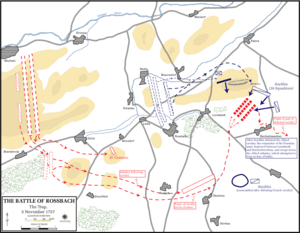
In 1756, Austria and France, who were usually enemies, formed an alliance. This was called the Diplomatic Revolution. Frederick quickly made an alliance with Great Britain. As neighboring countries planned against him, Frederick decided to attack first. On August 29, 1756, his army invaded Saxony. This started the Seven Years' War, which lasted until 1763. He was criticized for attacking neutral Saxony. He also forced Saxon soldiers into the Prussian army after the Siege of Pirna in October 1756.
Frederick faced a group of enemies including Austria, France, Russia, Saxony, and Sweden. His only allies were Great Britain and Hanover. Frederick managed to keep Prussia in the war, even though his lands were often invaded.
The sudden death of Empress Elizabeth of Russia changed things. Her nephew, Peter III, who liked Prussia, became ruler. This caused the anti-Prussian alliance to fall apart. Frederick did not gain any new land in the Treaty of Hubertusburg. However, he was able to keep Silesia. Prussia became popular in many German-speaking areas.
Later in his life, Frederick also got Prussia involved in the smaller War of the Bavarian Succession in 1778. In this war, he stopped Austria from trying to trade the Austrian Netherlands for Bavaria. When Emperor Joseph II tried this plan again in 1784, Frederick created the Fürstenbund. This made Germans see him as a protector of German freedoms.
Frederick often led his armies himself. Six horses were shot from under him during battles. He is admired as one of the greatest military thinkers. He was especially known for using the oblique order of battle. Even more important were his clever moves. He prevented larger enemy armies from joining forces. He was also in the right place at the right time to keep enemies out of Prussia. Emperor Joseph II of Austria wrote about Frederick:
When the King of Prussia speaks on problems connected with the art of war...everything is taut, solid and uncommonly instructive...A genius and a man who talks admirably.
Making Prussia Modern
Frederick changed Prussia from a less important European state into a strong and reformed country. His conquest of Silesia helped a lot. Silesia provided raw materials for Prussia's new industries. This boosted industrial production and development. He protected these industries with high taxes on imports and few limits on trade within the country.
In 1747, Frederick started a huge six-year project. He drained and "reclaimed" marsh-lands in the country's north. This project created about 150,000 acres of farmland. However, it also destroyed natural habitats and harmed the region's plant and animal life. It also displaced many local communities.
With help from French experts, Frederick also changed Prussia's tax system. He introduced a system of indirect taxation. This brought in more money than the old system of direct taxes. Frederick also asked the important Prussian merchant Johann Ernst Gotzkowsky to help improve trade. Gotzkowsky advised Frederick to change toll fees and import rules. He also suggested building a large silk factory to compete with France. In 1763, when Gotzkowsky faced financial problems, Frederick took over one of his porcelain factories.
Frederick also reformed the national money system. The Seven Years' War and getting Silesia had changed the economy. The national currency had lost value, leading to high inflation. The Prussian Mint Edict of May 1763 revalued the money. It made sure that taxes were paid in currency that had its pre-war value. Other European rulers soon made similar money reforms. This helped lower prices across the region.
Frederick also led other important efforts to modernize Prussia. He set up a modern government system. He helped create one of Europe's best education systems. He also ended torture and physical punishment.
After getting Royal Prussia (West Prussia) in 1772, Frederick changed his title. He went from "King in Prussia" to "King of Prussia." This showed how much more important his state and his own role as a ruler had become.
Religious Tolerance
Frederick generally supported religious tolerance. He welcomed Jesuits, who were fleeing persecution, as teachers in Silesia and other areas. He wanted to attract skilled people to his country. This included Jesuit teachers, Huguenot citizens, and Jewish merchants and bankers. He wanted development across the country.
Frederick wrote in his Testament politique about his practical approach to tolerance:
We have too many Jews in the towns. They are needed on the Polish border because in these areas Hebrews alone perform trade... I have never persecuted anyone from this or any other sect; I think, however, it would be prudent to pay attention, so that their numbers do not increase.
Jews near the Polish border were encouraged to trade. They received protection and support from the king, just like other Prussian citizens. The success of integrating Jews into these areas can be seen later. For example, Gerson von Bleichröder helped finance Bismarck's efforts to unite Germany.
Since Frederick made much wasteland usable, Prussia needed new settlers. Frederick often said that a person's nationality or religion didn't matter to him.
Architecture and Art
Frederick had famous buildings built in his capital, Berlin. Many of these still exist today. These include the Berlin State Opera, the Royal Library (now the State Library Berlin), and St. Hedwig's Cathedral. He also built Prince Henry's Palace, which is now Humboldt University.
However, the king preferred to spend his time in his summer home in Potsdam. There, he built the palace of Sanssouci. This is the most important example of Northern German rococo style. Sanssouci means "carefree" or "without worry" in French. It was a peaceful place for Frederick. The "Frederician Rococo" style developed under Georg Wenzeslaus von Knobelsdorff.
Later Years and Legacy
Near the end of his life, Frederick spent more and more time alone. His friends at Sanssouci gradually passed away, and he didn't replace them. Frederick became more critical and difficult. The people of Berlin always cheered him when he returned to the city. But Frederick didn't enjoy his popularity with common people. He preferred the company of his pet Italian greyhounds. He jokingly called them his 'marquises de Pompadour'. Frederick died in an armchair in his study at Sanssouci on August 17, 1786.
Frederick had wanted to be buried next to his greyhounds on the vineyard terrace at Sanssouci. But his nephew and successor, Frederick William II, ordered him to be buried next to his father. This was in the church of the Potsdam garrison.
Near the end of World War II, Adolf Hitler ordered Frederick's coffin moved. He also moved the coffins of Frederick William I, Paul von Hindenburg, and his wife. They were first taken to an underground bunker near Berlin. Then they were hidden in a salt mine in Germany to protect them. The US Army found the coffins on April 27, 1945. They were behind a thick wall deep inside the mine. The US Army moved them to Marburg Castle.
Later, as part of a secret project, the US Army moved both kings again. First, they went to the Elisabeth Church in Marburg. Then they were moved to Burg Hohenzollern. After German reunification, Frederick William I's body was buried in the Kaiser Friedrich Mausoleum at Sanssouci's Church of Peace.
On August 17, 1991, the 205th anniversary of his death, Frederick's casket was finally laid to rest. It was placed on the vineyard terrace of Sanssouci. This was done according to his last wish: "without pomp and at night."
Frederick in Popular Culture
Places Named After Him
King of Prussia, Pennsylvania, is named after an inn. That inn was named to honor Frederick.
Prussia Street in Dublin, Ireland, is also named after Frederick the Great.
German Films
The Great King (German: "Der Große König") is a 1942 German drama movie. It was directed by Veit Harlan and starred Otto Gebühr. The movie shows the life of Frederick the Great. It was considered a very important "movie of the Nation." Otto Gebühr played the King in many other movies too.
- Films with Otto Gebühr as Frederick the Great
- 1920: Die Tänzerin Barbarina – directed by Carl Boese
- 1921–23: Fridericus Rex – directed by Arzén von Cserépy
-
- Part 1 - Sturm und Drang
- Part 2 - Vater und Sohn
- Part 3 - Sanssouci
- Part 4 - Schicksalswende
- 1926: Die Mühle von Sans Souci – directed by Siegfried Philippi
- 1928: Der alte Fritz – 1. Teil Friede – directed by Gerhard Lamprecht
- 1928: Der alte Fritz – 2. Teil Ausklang – directed by Gerhard Lamprecht
- 1930: Das Flötenkonzert von Sanssouci – directed by Gustav Ucicky
- 1932: Die Tänzerin von Sans Souci – directed by Friedrich Zelnik
- 1933: Der Choral von Leuthen – directed by Carl Froelich
- 1936: Heiteres und Ernstes um den großen König – directed by Phil Jutzi
- 1936: Fridericus – directed by Johannes Meyer
- 1937: Das schöne Fräulein Schragg – directed by Hans Deppe
- 1942: Der große König – directed by Veit Harlan
In the 2004 German movie Der Untergang, Adolf Hitler is shown looking at a painting of Frederick. This might show Hitler's fading hopes for a "miracle" to save him.
American Films
In the 1970 movie Patton, General Patton incorrectly says that Frederick the Great said, "L'audace, l'audace, toujours l'audace!" This means "Audacity, audacity — always audacity!"
Frederick is mentioned several times in Stanley Kubrick's 1975 movie Barry Lyndon. In the movie, he is called "The great and illustrious Frederick." His army is both praised and criticized. For example, a quote from the film says: "During the five years which the war had now lasted, the great and illustrious Frederick had so exhausted the males of his kingdom that he had to employ scores of recruiters who hesitated no crime, including kidnapping, to keep supplied those brilliant regiments of his with food for powder."
Titles and Styles
- 24 January 1712 – 31 May 1740 His Royal Highness the Crown Prince
- 31 May 1740 – 19 February 1772 His Majesty the King in Prussia
- 19 February 1772 – 17 August 1786 His Majesty the King of Prussia
Images for kids
-
Frederick leading his troops at the Battle of Zorndorf, by Carl Röchling
-
Frederick and his soldiers after the Battle of Hochkirch in 1758, by Carl Röchling
-
The Polish–Lithuanian Commonwealth after the First Partition (1772)
-
Portrait by Wilhelm Camphausen, 1870
-
Frederick the Great by Anton Graff, 1781
-
The Round Table of King Frederick II in Sanssouci by Adolph Menzel. It shows Frederick with famous thinkers like Voltaire.
-
Frederick the Great and his staff at the Battle of Leuthen, by Hugo Ungewitter
-
Frederick before the Battle of Torgau, 1760
See also
 In Spanish: Federico II el Grande para niños
In Spanish: Federico II el Grande para niños


